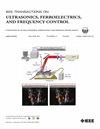High-Quality Passive Acoustic Mapping With the Cross-Correlated Angular Spectrum Method
IF 3.7
2区 工程技术
Q1 ACOUSTICS
IEEE transactions on ultrasonics, ferroelectrics, and frequency control
Pub Date : 2025-07-07
DOI:10.1109/TUFFC.2025.3586460
引用次数: 0
Abstract
While passive acoustic mapping (PAM) has been advanced for monitoring acoustic cavitation activity in focused ultrasound (FUS) therapy, achieving both real-time and high-quality imaging capabilities is still challenging. The angular spectrum (AS) method presents the most efficient algorithm for PAM, but it suffers from artifacts and low resolution due to the diffraction pattern of the imaging array. Data-adaptive beamformers suppress artifacts well, but their overwhelming computational complexity, more than two orders of magnitude higher than the classical time exposure acoustic (TEA) method, hinders their application in real time. In this work, we introduce the cross-correlated AS method to address the challenge. This method is based on cross-correlating the AS back-propagated wave fields, in the frequency domain (FD), measured by different apodized subapertures of the transducer array to provide the normalized cross-correlation coefficient (NCC) matrix for artifacts suppression. We observed that the spatial pattern of NCC matrix is variable, which can be utilized by the triple apodization with cross correlation (TAX) with AS scheme, namely, the AS-TAX method, for optimal artifacts suppression outcomes. Both the phantom and mouse tumor experiments showed that: 1) the AS-TAX method has comparable image quality as the data-adaptive beamformers, reducing the energy spread area (ESA) by 34.8%–65.0% and improving image signal-to-noise ratio (ISNR) by 10.6–14.4 dB compared to TEA; 2) it reduces the computational complexity by two orders of magnitude compared to TEA allowing millisecond-level image reconstruction speed with a parallel implementation; and 3) it can well map microbubble cavitation activity of different status (stable or inertial). The AS-TAX method represents a real-time approach to monitor cavitation-based FUS therapy with high image quality.交叉相关角谱法的高质量被动声学映射。
虽然被动声成像(PAM)在聚焦超声(FUS)治疗中监测声空化活动方面取得了进展,但实现实时和高质量的成像能力仍然具有挑战性。角谱法(AS)是最有效的PAM算法,但由于成像阵列的衍射模式,存在伪影和低分辨率。数据自适应波束形成器可以很好地抑制伪影,但其压倒性的计算复杂性(比经典的时间曝光声学(TEA)方法高出两个数量级以上)阻碍了其实时应用。在这项工作中,我们引入了交叉相关的AS方法来解决这一挑战。该方法基于在频域内,通过换能器阵列的不同apozed子孔径测量的AS反向传播波场相互关联,提供归一化相关系数(NCC)矩阵,用于伪影抑制。我们观察到NCC矩阵的空间格局是可变的,可以利用与AS方案相结合的互相关三重apodiization (TAX),即AS-TAX方法来获得最佳的伪影抑制结果。幻象和小鼠肿瘤实验表明:1)与TEA相比,as - tax方法的图像质量与数据自适应波束形成方法相当,能量扩展面积减小34.8% ~ 65.0%,图像信噪比提高10.6% ~ 14.4 dB;2)与TEA相比,它将计算复杂度降低了两个数量级,允许并行实现毫秒级的图像重建速度;3)可以很好地绘制不同状态(稳定或惯性)的微泡空化活动。AS-TAX方法代表了一种实时监测基于空化的FUS治疗的高图像质量方法。
本文章由计算机程序翻译,如有差异,请以英文原文为准。
求助全文
约1分钟内获得全文
求助全文
来源期刊
CiteScore
7.70
自引率
16.70%
发文量
583
审稿时长
4.5 months
期刊介绍:
IEEE Transactions on Ultrasonics, Ferroelectrics and Frequency Control includes the theory, technology, materials, and applications relating to: (1) the generation, transmission, and detection of ultrasonic waves and related phenomena; (2) medical ultrasound, including hyperthermia, bioeffects, tissue characterization and imaging; (3) ferroelectric, piezoelectric, and piezomagnetic materials, including crystals, polycrystalline solids, films, polymers, and composites; (4) frequency control, timing and time distribution, including crystal oscillators and other means of classical frequency control, and atomic, molecular and laser frequency control standards. Areas of interest range from fundamental studies to the design and/or applications of devices and systems.

 求助内容:
求助内容: 应助结果提醒方式:
应助结果提醒方式:


